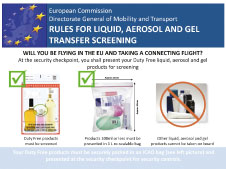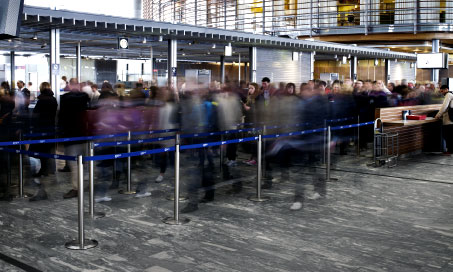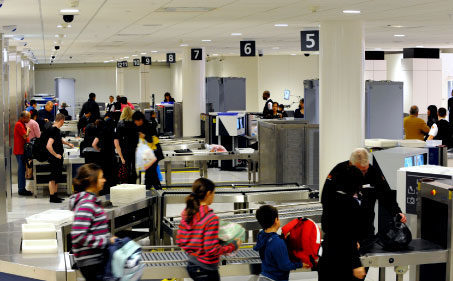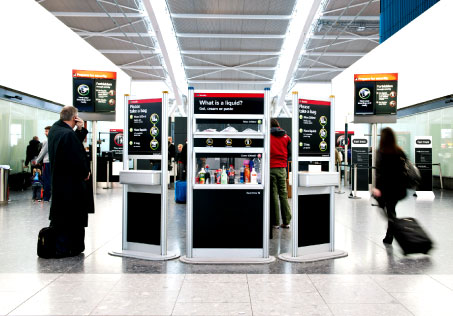
ACI EUROPE has produced a flyer providing clear information to passengers about what the new rules will mean for them from 31 January 2014.
Ask any traveller to identify the one change that would enhance their airport experience and it would likely be the ability to carry liquids on board without the need for them to be removed from hand baggage and screened separately. The LAGs restrictions have redefined the airport security experience and perhaps had the deepest impact on the overall passenger experience in recent years. All the while, airports are striving to minimise waiting times and inconvenience to travellers, while maintaining stringent security levels.

The TSA, the European Commission and industry stakeholders, including ACI EUROPE, will continue their collaborative efforts to find a comprehensive risk-based security solution for identifying liquid explosives that will facilitate the lifting of the current LAGs restrictions as soon as practical.
The US Department of Homeland Security, Transportation Security Administration (TSA) and the European Commission, along with a number of other countries, put in place restrictions on LAGs to counter a threat to international civil aviation – a threat that remains real today. These restrictions were intended to be temporary, with a view to being replaced by a technological solution that will deliver a comparable level of security for international flights and will provide passengers the convenience to once again travel with LAGs of all types, shapes and sizes in their carry-on baggage. Over time, progress has been made in screening technologies, with a number of systems passing laboratory tests and undergoing field tests under a variety of screening scenarios. ACI EUROPE supported the postponement of the 2013 deadline, and has unswervingly argued that the removal of restrictions must be based on a sustainable technological solution with a high degree of probability of detection of a wide range of liquid explosives, while also being passenger-friendly. ACI EUROPE in collaboration with other industry stakeholders has also produced a flyer providing clear information to passengers about what the new rules will mean for them from 31 January 2014.
The TSA, the European Commission and industry stakeholders, including ACI EUROPE, will continue their collaborative efforts to find a comprehensive risk-based security solution for identifying liquid explosives that will facilitate the lifting of the current LAGs restrictions as soon as practical, while maintaining security and facilitating the movement of passengers and commerce in international civil aviation.
Following a series of false starts, the new phased approach is designed to ensure operational feasibility while maintaining the required high level of security. The first phase of this progressive roadmap, applicable from January 2014, is designed to test the operational impact of screening LAGs. Involving a limited range of liquids, it is expected to have a minimal impact on airport screening operations based on the existing level of LAGs carried by passengers.

Perhaps the biggest change travellers will notice when transferring through EU airports from January will be the ability to carry duty free LAGs purchases onboard their next flight; passengers will need to present these items in sealed Security Tamper Evident Bags (STEBs) alongside proof of purchase.
Perhaps the biggest change travellers will notice when transferring through EU airports from January will be the ability to carry duty free LAGs purchases onboard their next flight; passengers will need to present these items in sealed Security Tamper Evident Bags (STEBs) alongside proof of purchase. It is a welcome development. The confiscation of duty free LAGs has, undoubtedly, had the most profoundly detrimental impact on the passenger experience, causing confusion and consternation, and ultimately impacting negatively on duty free revenues, with passengers uncertain what they can carry. It is also important to note here that the new rules have been adopted in coordination with major EU trading partners, including the US, Canada and Australia, enabling EU passengers to carry their LAGs in STEBs when transferring in those countries.

The first phase of the new roadmap, applicable from January 2014, is designed to test the operational impact of screening LAGs. Involving a limited range of liquids, it is expected to have a minimal impact on airport screening operations based on the existing level of LAGs carried by passengers. (Photo © Heathrow Airport)
All other LAGs must not exceed 100ml and must fit in a transparent one-litre resealable plastic bag. Additionally, liquids needed during the trip for medical purposes or special dietary requirements, including baby food, are allowed.
Marjeta Jager, Director of Security for the Directorate-General for Transport and Mobility of the European Commission, commented to Airport Business: “We have worked tirelessly with EU Member States, industry stakeholders and international partners to give passengers back the possibility to take liquids on planes. By the end of January, we intend to start with duty free liquid purchases which will be accepted for screening at security checkpoints in European airports provided they are sealed in STEBs as designed by the International Civil Aviation Organisation. This is good news for air travellers, as it puts convenience back into the equation for providing a positive travel experience without compromising on security.”
Phase two, and subsequent phases, are dependent on acceptable implementation of the preceding phase, with an assessment that adding additional types of LAGs is operationally-feasible and provides effective security. After false dawns in 2011 and 2013, the new roadmap provides a more realistic, phased approach, which should lead towards the full lifting of restrictions over the next few years, improving the travel experience for all passengers.







